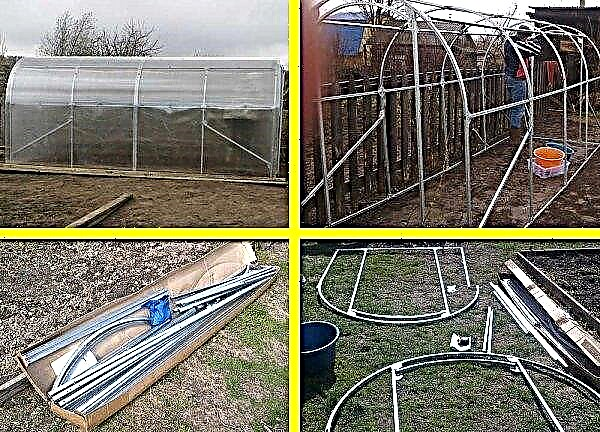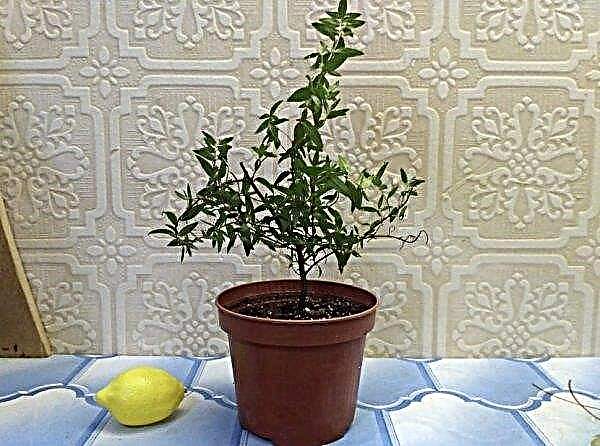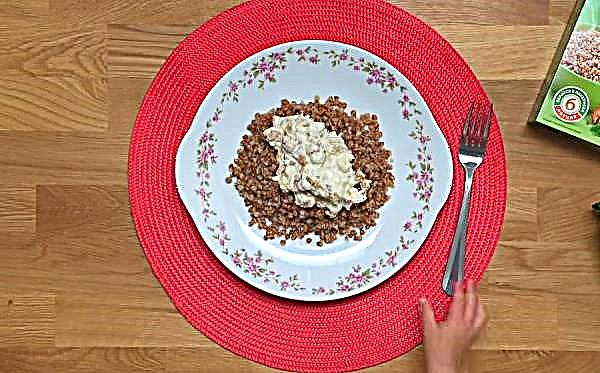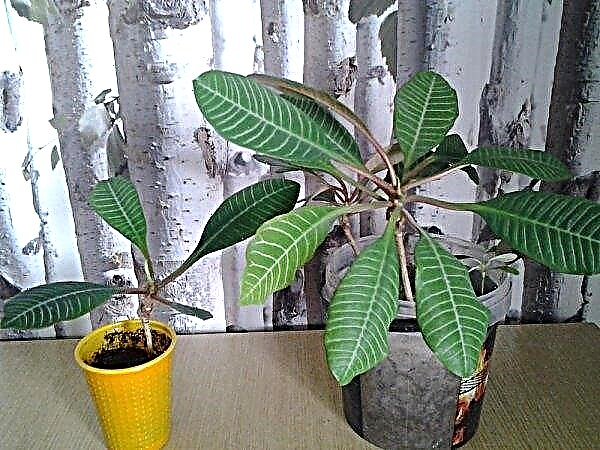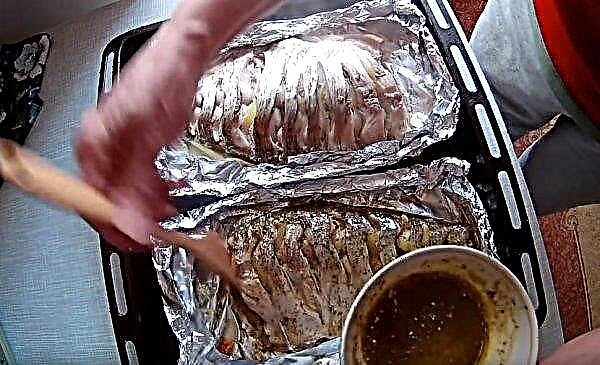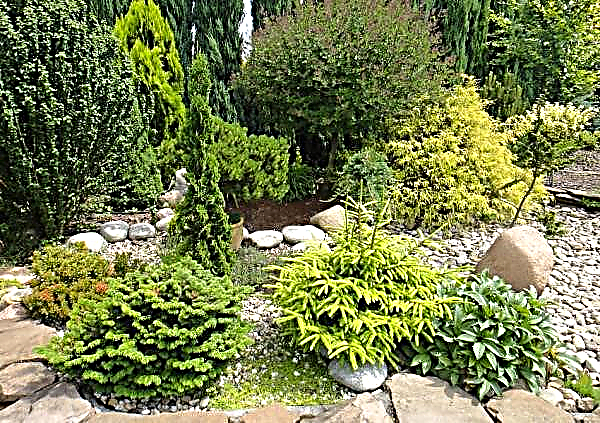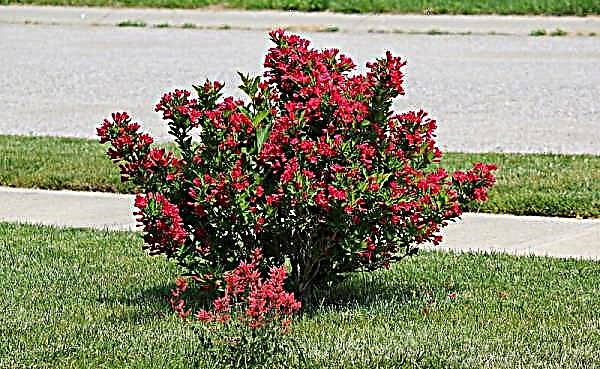When choosing seed, it is difficult to find a tomato variety that was successful in growing and did not disappoint with the quantity of the crop from the first try. Variety "Volgogradsky" is an excellent precocious variety suitable for gardeners with experience in vegetable growing and for beginners, as it is rather unpretentious in maintenance and can please with an excellent harvest annually.
Features and description of the variety
The tomato variety “Volgogradsky” was bred at the Volgograd Experimental Station as a result of breeding of different varieties of tomatoes. This made it possible to obtain a vegetable crop that yields high yields both in the southern regions and in the middle lane. The plant is unpretentious, can be grown in remote suburban areas and gardens, as it does not require daily care.
"Volgograd" variety combines under one name several varieties of tomatoes:Did you know? World selection totals more than 10000 varieties of tomatoes. The mass of the largest fruit is 1.5 kg.
- 5/95 - medium ripeness, is the "founder" of the variety, bred in 1953;
- precocious 323 - received in 1973;
- pink - is an early variety.
 The consumer qualities of these varieties and some characteristics are completely identical, however, there are differences, and they must be taken into account when choosing a variety and cultivation:
The consumer qualities of these varieties and some characteristics are completely identical, however, there are differences, and they must be taken into account when choosing a variety and cultivation:
- "Volgograd" can be characterized as an early variety, because it ripens quite quickly. The terms are as follows: 323 and pink - 90-100 days, 5/95 - 115-120 days;
- variety bushes are quite compact: 323 has a height of 0.25–0.40 m, pink - 0.60 m, 5/95 - 0.7–1 m;
- despite its compact size, it requires the formation of a bush and stepson, but some gardeners note that they do not do stepsoning;
- the bush has a well-developed thick trunk, so undersized varieties of the variety do not need additional support and tying, but it is better to tie up 5/95;
- the leaves are medium sized, but the variety is not abundant in greenery;
- the first ovary is formed over the 4th – 5th real leaf, the subsequent ovaries alternate at intervals in one leaf or go several pieces in a row;
- on each brush up to 6 fruits can form;
- the shape of the fruit is round-flat;
- the color of the fruit is red-orange (323, 5/95) or pink;
- the average weight of tomatoes: 323 - 80–100 g, 5/95 - 90–150 g, pink - 100–130 g;
- the peel is shiny, dense, does not crack;
- sweet and sour flesh, fleshy, medium density, dry matter contains 5-6%, sugar - 3%;
- average yield: 4.5-7 kg of tomatoes per 1 sq. km. m;
- planting density: 3-4 bushes per 1 square. m;
- can ripen in a torn form without losing taste.
Photo gallery
Pros and cons of the variety
- The advantages of tomatoes "Volgograd" include:
- excellent tolerance of temperature jumps (day / night, sudden cold snap, drought, etc.);
- the possibility of growing in open ground, a greenhouse, a greenhouse;
- unpretentiousness in leaving;
- a small set of leaves allows fruits to be evenly shined with sunshine;
- stable yield;
- uniform ripening of tomatoes;
- the same size of all tomatoes on the bush;
- high palatability of the fetus;
- excellent presentation;
- Suitability for long-term storage;
- tolerates transportation well;
- universality of application without loss of taste;
- resistance to characteristic diseases and pests.
Based on the feedback from gardeners, it can be argued that Volgogradsky is practically devoid of flaws. Some note only intolerance to seedlings of excess moisture, so you should be more careful about watering.
Sowing and growing
"Volgograd" tomato is characterized by a high percentage of seed germination. To get an early crop, use the method of growing seedlings. For grade 5/95, this method is the only possible one. However, for other varieties, it is possible to practice sowing directly into the soil in compliance with the technology and growing rules, only with this method there will be a natural delay in fruiting for about 2 weeks. Seedling time for seedlings:
Seedling time for seedlings:
- for heated greenhouses - the beginning of February;
- for ordinary greenhouses and hotbeds - the second half of March;
- for planting in open ground, a stable positive temperature must be established day and night.
Optimal conditions
Until the first seedlings appear, the temperature regime of seeds is maintained at + 23–25 ° C, but no more. The film, which is previously covered with a container of seeds, will maintain a sufficient level of moisture for germination. However, when the first sprouts appear, the film must be removed, since excessive evaporation will adversely affect the development of seedlings. Doing it better in the afternoon. The first seedlings are watered very carefully with a finely sprayed jet in a small amount, avoiding overflow. It is recommended to change the temperature regime periodically to harden seedlings. The plants are hardened for 3 days in a row, then returned to normal cultivation and again after a while repeat the procedure. In total, the hardening period of seedlings should last 15 days.
The first seedlings are watered very carefully with a finely sprayed jet in a small amount, avoiding overflow. It is recommended to change the temperature regime periodically to harden seedlings. The plants are hardened for 3 days in a row, then returned to normal cultivation and again after a while repeat the procedure. In total, the hardening period of seedlings should last 15 days.
For the healthy development of plants, they need good lighting. Together with the correct temperature regime, this will not allow the seedlings to stretch excessively in growth. If there is not enough light, then it is compensated by artificial illumination with fluorescent lamps, organizing daylight hours of 12-14 hours. While the seeds did not germinate, they did not care about the level of illumination.Important! For gentle watering of seedlings, it is better to use not a watering can, but a spray gun.
Preparation and sowing technology
For seeds before planting, it is recommended to carry out a number of preparatory measures for disinfection and in order to improve germination. Weigh-grade seeds of the variety are selected and warmed up in this mode: first 48 hours at a temperature close to +30 ° C, then 72 hours at +50 ° C. Sowing is carried out in dry form or the seeds are moistened with a weak 1% potassium permanganate solution - the seeds are lowered into it for 30 minutes. After that, they are removed and washed well in running water (can be left for 10 minutes). Small plastic containers, special seedling cassettes, boxes, etc., which are disinfected before sowing, are selected for sowing containers. Be sure to provide bottom drainage holes in the container to prevent root decay and the development of the black leg at the earliest stage of growing tomatoes.
Small plastic containers, special seedling cassettes, boxes, etc., which are disinfected before sowing, are selected for sowing containers. Be sure to provide bottom drainage holes in the container to prevent root decay and the development of the black leg at the earliest stage of growing tomatoes.
Under the bulk soil take any universal substrate. You can prepare the mixture yourself from peat and sand, which are mixed in equal proportions. If you use land from the garden, then it is pre-disinfected in the oven and mixed with sand and peat. Before sowing, the soil is well moistened.
Tomato seeds are buried in the soil about 1 cm indented from each other by 3 cm. The surface is moistened with a spray gun and covered with a film, thereby creating greenhouse conditions for friendly germination and maintaining soil moisture. After seed germination, the film is removed. Further, observing the temperature regime, seedlings are grown up to 2 true leaves. In this phase, picking plants and rejecting weak seedlings is carried out. Pickled tomatoes are again transplanted into separate containers prepared with soil, but this time the seedlings are buried in the ground to cotyledonous leaves to form a strong stem and a developed root system. 2 weeks after the pick, you can fertilize seedlings with complex fertilizers. Secondary dressing is introduced a week before landing on the beds.
2 weeks after the pick, you can fertilize seedlings with complex fertilizers. Secondary dressing is introduced a week before landing on the beds.
In open ground, tomato seeds are sown differently:Important! If the leaves of seedlings have acquired a dark green color, and a crimson hue is observed on their lower side, then your plants lack phosphorus. You can make up for it by adding phosphates.
- on prepared beds form landing holes;
- Variety "Volgogradsky" refers to the determinant type, so the bushes can be at a distance of 30-40 cm from each other;
- the earth is abundantly watered with warm water;
- 3-5 seeds are distributed in each hole, they are not sprinkled too much and watered again;
- the bed is covered with a dense non-woven material for insulation and is not opened until the seeds germinate;
- from each well, the most promising shoots for cultivation are left.

Seedling Planting Technology
Seedlings are ready for planting in 45-60 days. If it is grown qualitatively, the height reaches about 17–20 cm, and 9–10 leaves are formed on the stem. For planting in a greenhouse under cover material, early May in warm regions and the end of the month in the middle lane may be suitable.
The beds where the Volgogradsky tomato is supposed to be grown are prepared in advance, starting in the fall. Under the autumn digging make fertilizers. Depending on the acidity of the soil, it can be humus, compost, lime, superphosphate and so on. If on the plot allocated for tomatoes before that vegetables were grown and they were given the necessary top dressing, fertilizers should not be applied in the autumn, but you just need to dig them up, and in the spring, add ammonium nitrate.
Crop rotation for tomatoes is important, but not essential. It would be better for the development of plants if the predecessors of tomatoes last year were, for example, cabbage, legumes, carrots, cucumbers, eggplant, zucchini, parsley. Tomato seedlings are planted in deep holes, which are dug at a distance of 30-40 cm from each other, the pitch between the rows can be slightly increased to 30-50 cm. Each hole is watered abundantly - up to 0.9 l.
Tomato seedlings are planted in deep holes, which are dug at a distance of 30-40 cm from each other, the pitch between the rows can be slightly increased to 30-50 cm. Each hole is watered abundantly - up to 0.9 l.
Seedlings are placed individually in each hole. The roots neatly straighten to the bottom of the hole. The stem is buried more than the tomato was previously planted in the seedling tank. Sometimes vegetable growers are advised to cut off the lower leaves and deepen the stem even further into the ground so that the root system develops more intensively. The roots for tomatoes are extremely important, since they are the main conductor of all the nutrients for the life of the plant.Important! The size and depth of the holes for planting should be such that they can freely fit the entire root system and stem to the first leaves. The deeper the planting, the less often it will be necessary to water the seedlings.
 Seedlings can be laid with a slight slope to the north or north-west. The hole is sprinkled with earth, carefully ramming around the roots and stem. Then planting is watered and sprinkled with earth a little more to preserve moisture.
Seedlings can be laid with a slight slope to the north or north-west. The hole is sprinkled with earth, carefully ramming around the roots and stem. Then planting is watered and sprinkled with earth a little more to preserve moisture.Tomato Care
The rules for caring for tomatoes consist of a series of activities that are necessary for all vegetable crops. Variety "Volgogradsky" does not impose special requirements in this regard, and timely watering, top dressing, weeding, disease prevention contribute to obtaining an excellent tomato crop on the site.
Did you know? Frequent use of tomatoes and dishes from them can reduce the risk of cancer.
Fertilizer and watering
Watering seedlings and adult plants of the Volgogradsky variety is rare, but plentiful. If you are worried in advance about a deep landing in the ground, then you can give water to the tomatoes 1 time in 10 days. The frequency of watering increases with increasing daily temperature. A thermometer mark of +30 ° C will let you know that you should water more often. Watering is recommended to be done in the evening with warm water. The amount of water poured under the roots should be a measure. At the same time, the overdrying of the earth and its excessive moisture should not be allowed. Excess moisture can lead to root diseases, and during the fruit ovary period it can cause cracking of tomatoes. It is easy to check how much the plant needs watering by controlling the soil moisture: if it is moist at a depth of 10 cm, then watering is not required.
The amount of water poured under the roots should be a measure. At the same time, the overdrying of the earth and its excessive moisture should not be allowed. Excess moisture can lead to root diseases, and during the fruit ovary period it can cause cracking of tomatoes. It is easy to check how much the plant needs watering by controlling the soil moisture: if it is moist at a depth of 10 cm, then watering is not required.
An excellent yield of a variety is affected by plant nutrition. During the growing period, you can fertilize with complex mineral or organic (infusions of manure or bird droppings) fertilizers 2-3 times:
- First step top dressing is carried out 10-12 days after planting. A mixture of organic and mineral fertilizers is introduced: 1 liter of slurry and 20 g of superphosphate are taken per 10 liters of water. The mixture is distributed in 10 bushes.
- Second phase fertilizing will take place after 2 weeks with dry mixtures of mineral fertilizers. Fertilizer is applied for earthing up or immediately after loosening the soil, based on the calculation: 20 g of superphosphate, 15 g of potassium salt, 10 g of ammonium nitrate per 1 sq. Km. m
- Third stage completely repeats the second and lags behind him in time also by 2 weeks.
Video: How to feed tomatoes in the open field
Pasynkovka and formation of a bush
The low bush of "Volgogradsky" does not exclude the fact that it needs to be formed and timely to pinch the lateral processes. Some vegetable growers refuse to pinch in favor of increasing tomato yields. This decision is also promoted by the low foliage of the bushes, and the plant copes well with the ripening of the fruit without outside interference. However, to improve the friendly ripening of fruits and obtain them on a larger scale, removing stepchildren from the stem is still necessary.
Important! When tearing off stepsons, it is important to remove them not near the stem itself, but to leave a small “stump” - otherwise shoots will grow again at this place.
At the middle-growing tomato “Volgogradsky 5/95”, only the uppermost shoot is left during the stepsoning, the rest is removed. In low-growing varieties, especially when grown in open ground, 3 upper shoots are left or all stepsons are removed to the first formed fruit brush.
Soil cultivation and weeding
Weeding of tomatoes is carried out according to the general requirements for growing vegetables: there should be no weeds in the beds. They are especially carefully weeded during the period of active plant growth, when the seedlings have not yet become stronger.
Tomatoes have a superficial root system, so do not loosen the soil near the stem: it is very easy to damage the roots. Instead of loosening, it is recommended to carry out a small hilling of the bush: 2-3 times before the period when the fruits begin to set.
Harvesting and storage
Harvesting is started at a time when the fruits have acquired a characteristic color for the variety and have ripened. Vegetables can be removed from the bush and a little immature: they perfectly mature themselves, while the taste is completely unchanged. It is recommended to collect tomatoes before evening coolness or in the early morning, so that there is no dew. It is worth tearing them off with the stalk, since if it is available, the fruits are stored better. If there is arid or excessively hot weather, the Volgogradsky variety does not pigment the fruit actively enough, so their redness has to wait longer. You can remove the tomatoes from the branch, but it will be correct to wait a few days for the tomato to ripen and be saturated with a lot of vitamins.
If there is arid or excessively hot weather, the Volgogradsky variety does not pigment the fruit actively enough, so their redness has to wait longer. You can remove the tomatoes from the branch, but it will be correct to wait a few days for the tomato to ripen and be saturated with a lot of vitamins.
Torn tomatoes are stored in wooden or plastic containers in which vegetables are stacked in rows with the stalk up. The maximum number of rows is 3. The storage room should be cool and dark (refrigerator, cellar, basement). Comfortable storage temperature - + 5–12 ° С at a relative humidity of 80%.
For storage, fruits with whole skin are sorted, without damage. Tomatoes that have reached milk maturity (brown) and have acquired the size characteristic of the variety are perfect. Periodically check containers and discard vegetables that begin to deteriorate.
Diseases and pests
Variety "Volgogradsky" was bred a long time ago, so it can not cope very well with modern strains of diseases, although it has been selected for excellent resistance to diseases and pests. It does not hurt, without waiting for the first signs of plant disease, to process the beds with tomatoes fungicides.
Most often, the variety is affected:
- late blight. In the fight against phytosporosis at the initial stage, spraying with Fitosporin will help. If the disease progresses, then use stronger special chemicals;
- powdery mildew. Prevention is carried out by spraying with sodium humate (0.1% solution), with the spread of the disease, they switch to Alirin-B, Gamair, Topaz, Fundazol and others;

- verticillosis and cladosporiosis. They are not familiar to modern hybrids, but for Volgogradsky they can be a threat. Diseases can be avoided by simple crop rotation rules, without planting tomatoes in a row for several years in the same place. If this is not possible, for example, when planting seedlings in a greenhouse, then the soil is disinfected with boiling water. The event should be carried out 1-2 days before planting.

From insects, such as whiteflies, spider mites or thrips, during their massive foray into tomatoes, spraying with insecticides, such as Actofit, will save. Aphids can be removed from plants with an aqueous solution of ordinary laundry soap.Important! All spraying with chemical compounds should be carried out no later than 40 days before harvesting. For the Volgogradsky variety, this is May-June.
Tomato "Volgogradsky" showed itself well in cultivation on various types of soils in private and farm households due to simple cultivation and sustainable abundant crops. The variety is universal in the further use of fruits and can ripen in greenhouses, hotbeds and open ground with equal success.






